The Digital Media Adapters Market is estimated to be valued at USD 3.8 billion in 2025 and is projected to reach USD 6.8 billion by 2035, registering a compound annual growth rate (CAGR) of 6.0% over the forecast period.
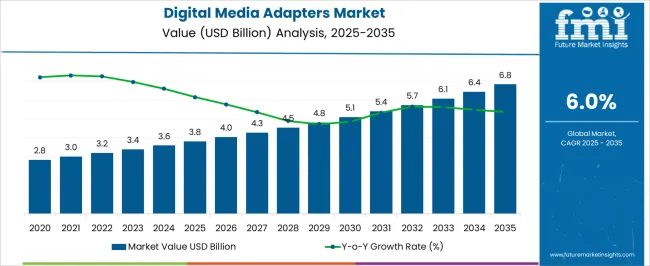
| Metric | Value |
|---|---|
| Digital Media Adapters Market Estimated Value in (2025 E) | USD 3.8 billion |
| Digital Media Adapters Market Forecast Value in (2035 F) | USD 6.8 billion |
| Forecast CAGR (2025 to 2035) | 6.0% |
The digital media adapters market is witnessing accelerated growth as consumers and enterprises increasingly adopt streaming devices to access on-demand digital content. The shift from traditional broadcast systems to internet-based streaming is reshaping entertainment and media consumption patterns globally. Demand is being fueled by advancements in wireless connectivity, affordable broadband access, and the growing ecosystem of content providers offering high-definition and ultra-high-definition content.
Ease of integration with multiple platforms, compatibility with smart TVs, and affordability are also playing a significant role in expanding adoption. Manufacturers are focusing on compact designs and intuitive interfaces to enhance user experiences, while continuous software updates ensure compatibility with evolving content formats and services.
Rising demand from residential households for cord-cutting solutions and the expanding use of digital adapters in commercial environments such as hotels and offices are shaping long-term prospects As internet penetration deepens and video streaming continues to dominate content consumption, the market for digital media adapters is positioned for sustained growth, with opportunities emerging from evolving customer expectations and rapid technological advancements.
The digital media adapters market is segmented by type, product type, application, end user, and geographic regions. By type, digital media adapters market is divided into Roku Streaming Stick, Apple TV, Google’s Chromecast, Amazon Fire TV Stick, and Others. In terms of product type, digital media adapters market is classified into Wireless Digital Media Adapters and Wired Digital Media Adapters. Based on application, digital media adapters market is segmented into Residential Use and Commercial Use. By end user, digital media adapters market is segmented into TV, Media Player, Phone, and Computer. Regionally, the digital media adapters industry is classified into North America, Latin America, Western Europe, Eastern Europe, Balkan & Baltic Countries, Russia & Belarus, Central Asia, East Asia, South Asia & Pacific, and the Middle East & Africa.
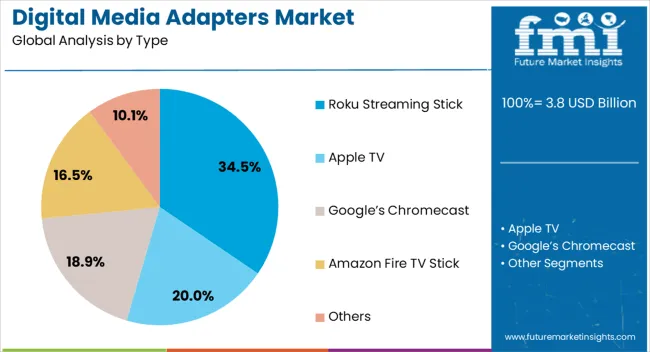
The Roku streaming stick segment is projected to hold 34.5% of the digital media adapters market revenue share in 2025, making it the leading type. Its leadership is being reinforced by affordability, compact form factor, and wide compatibility with multiple television models. The device’s ability to deliver high-quality streaming across various platforms without the need for bulky equipment has supported its strong consumer appeal.
Continuous software updates that enhance interface usability and expand channel access are further strengthening its dominance. The streaming stick format is also benefiting from the trend of cord-cutting, as consumers increasingly opt for flexible, internet-based media consumption rather than traditional cable services.
Its portability and ease of setup make it particularly attractive for residential users who value convenience and flexibility The balance between cost-effectiveness and reliable performance has made the Roku streaming stick a preferred choice for households, contributing significantly to its revenue leadership within the type segment of the digital media adapters market.
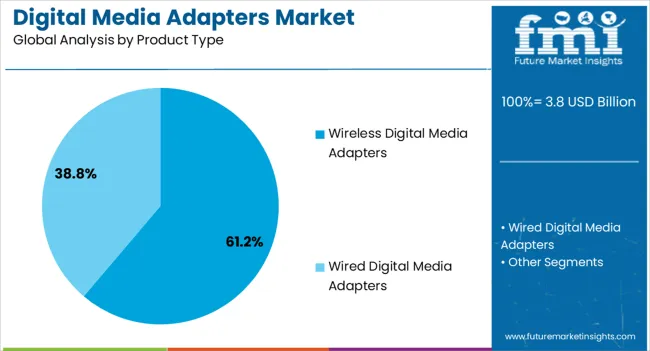
The wireless digital media adapters segment is anticipated to account for 61.2% of the market revenue share in 2025, positioning it as the leading product type. Its dominance is being driven by the growing demand for cable-free and clutter-free home entertainment setups, as consumers seek seamless connectivity solutions. Wireless adapters enable users to stream high-definition and ultra-high-definition content directly to televisions and displays without physical connections, aligning with modern preferences for minimalistic design and convenience.
Advancements in Wi-Fi technology and faster broadband access are enhancing streaming quality and reducing latency, making wireless devices more attractive than traditional wired alternatives. Manufacturers are integrating multi-device compatibility features, allowing users to connect smartphones, tablets, and laptops effortlessly.
Increasing adoption in both residential and commercial environments, including hotels and offices, is further reinforcing this segment’s growth As consumers continue to prioritize flexibility, convenience, and performance, wireless digital media adapters are expected to remain the leading product type within the global market.
A digital media adapter, commonly known as DMA, is an innovative electronic device that is utilized for connecting the computer to a home media system. It is capable of transferring audio content and digital files at a fast pace.
It consists of a collection of applications, a processor, and an advanced operating system to gain access to various streaming services, High-Definition Multimedia Interface (HDMI) port, and in-built Wi-Fi receiver for connecting to a television set. It helps users to locate multiple online media files and move them to visual or audio equipment.
It provides high streaming quality and there are no problems with clear audio transmissions, as well as no sudden frame freezes on video streams. Some of the recently introduced adapters feature in-built software solutions that enable users to record the media in real time and save it for viewing later.
The increasing usage of digital media adapters for viewing video content is expected to contribute to the market revenue growth. The surging penetration of the internet among millennials is another significant factor that is set to push the sales of digital media adapters in the near future.
Changing lifestyles and high disposable income of people are propelling the adoption of cutting-edge home theater systems across the globe. This is likely to boost the popularity of Video on Demand (VoD) or web series.
The easy availability of high-speed internet connections and the growing usage of smartphones are anticipated to drive the demand for VoD. It is expected to result in the inclination of people towards online video content, which would affect the market positively.
Many manufacturers are expected to create a pre-defined list of channels that would be embedded in the media adapters. It is set to help users in choosing from the list of available content and viewing it either by purchasing a subscription plan or for free.
The increasing trend of home automation is another key factor that is likely to bode well for the market. The need to connect various electronic gadgets and devices to the DMA and home network in smart homes is projected to surge the digital media adapters market share.
Digital media adapters are difficult to operate, especially when used by the aging population. These are also expensive, as compared to the conventional systems. The lack of technologically advanced infrastructure and expertise in emerging economies may hamper the growth in this market. Various integration issues associated with an organization’s internal processes can also hinder the growth.
North America is expected to dominate in terms of the digital media adapters market share in future. The high demand for video streaming solutions, early adoption of advanced technology, and the presence of an established network infrastructure are anticipated to augur well for the market.
The increasing usage of smart home entertainment solutions and the entry of various renowned manufacturers in the USA is another factor that is likely to spur the market in North America. The emergence of novel adapters with inbuilt Wi-Fi for wireless connection from television screens, tablets, smartphones, and computers would also drive the market.
The introduction of new streaming services in Canada and the USA is projected to augment the market. Numerous companies are also set to provide attractive discounts on subscription of streaming services if purchased along with their adapters.
The high demand for smart TVs is anticipated to accelerate the sales of digital media adapters in Asia Pacific. The presence of prominent OTT platforms, such as Netflix, Disney+Hotstar, Sony Liv, and Amazon Prime in several Asia Pacific countries, such as India, China, Singapore, and Malaysia is expected to propel the growth.
The surging demand for video streaming and the increasing expenditure on smart home solutions are set to accelerate the market. The urgent need to remove clutter around the TV set is likely to propel the demand for digital media adapters in Asia Pacific as these are consistently developed in compact sizes.
Some of the key participants present in the global digital media adapters market include Roku, Inc., Microsoft, SAMSUNG, Soundstream, Apple Inc., Amazon, HUBER+SUHNER, Zyxel, Google, Power Acoustik, Seagate Technology LLC, Cisco Systems, Inc., Sony Corporation, ARCHOS, Dolby Laboratories, Inc., NETGEAR, Dell Inc., Alpine Electronics of America, Inc., and Pioneer Electronics (USA) Inc. among others.
Key market participants are engaging in acquisitions and mergers to broaden their presence in the highly competitive market and generate more sales worldwide. Some of the other key players are focusing on enrolling customers in their free platforms by using advertisements and then pitching them with unique offers and discounts to convince them to purchase subscription plans.
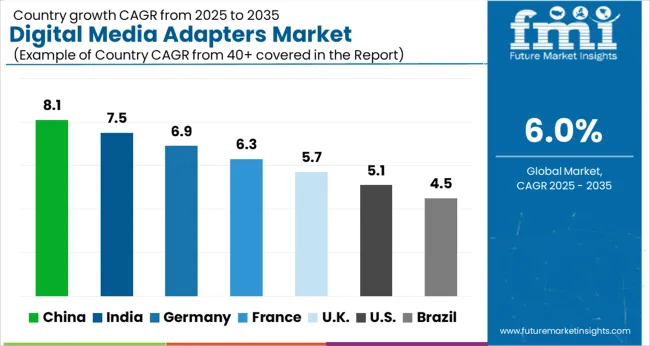
| Country | CAGR |
|---|---|
| China | 8.1% |
| India | 7.5% |
| Germany | 6.9% |
| France | 6.3% |
| UK | 5.7% |
| USA | 5.1% |
| Brazil | 4.5% |
The Digital Media Adapters Market is expected to register a CAGR of 6.0% during the forecast period, exhibiting varied country level momentum. China leads with the highest CAGR of 8.1%, followed by India at 7.5%. Developed markets such as Germany, France, and the UK continue to expand steadily, while the USA is likely to grow at consistent rates. Brazil posts the lowest CAGR at 4.5%, yet still underscores a broadly positive trajectory for the global Digital Media Adapters Market. In 2024, Germany held a dominant revenue in the Western Europe market and is expected to grow with a CAGR of 6.9%. The USA Digital Media Adapters Market is estimated to be valued at USD 1.3 billion in 2025 and is anticipated to reach a valuation of USD 2.1 billion by 2035. Sales are projected to rise at a CAGR of 5.1% over the forecast period between 2025 and 2035. While Japan and South Korea markets are estimated to be valued at USD 176.0 million and USD 118.6 million respectively in 2025.
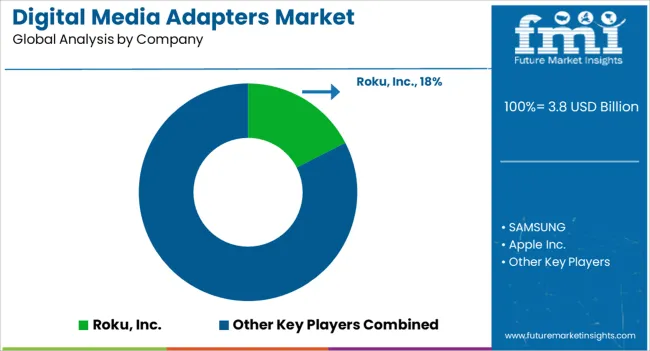
| Item | Value |
|---|---|
| Quantitative Units | USD 3.8 Billion |
| Type | Roku Streaming Stick, Apple TV, Google’s Chromecast, Amazon Fire TV Stick, and Others |
| Product Type | Wireless Digital Media Adapters and Wired Digital Media Adapters |
| Application | Residential Use and Commercial Use |
| End User | TV, Media Player, Phone, and Computer |
| Regions Covered | North America, Europe, Asia-Pacific, Latin America, Middle East & Africa |
| Country Covered | United States, Canada, Germany, France, United Kingdom, China, Japan, India, Brazil, South Africa |
| Key Companies Profiled | Roku, Inc., SAMSUNG, Apple Inc., Cisco Systems, Inc., Microsoft, Google, Pioneer Electronics (USA) Inc., Soundstream Sony Corporation, and Amazon |
The global digital media adapters market is estimated to be valued at USD 3.8 billion in 2025.
The market size for the digital media adapters market is projected to reach USD 6.8 billion by 2035.
The digital media adapters market is expected to grow at a 6.0% CAGR between 2025 and 2035.
The key product types in digital media adapters market are roku streaming stick, apple tv, google’s chromecast, amazon fire tv stick and others.
In terms of product type, wireless digital media adapters segment to command 61.2% share in the digital media adapters market in 2025.






Our Research Products

The "Full Research Suite" delivers actionable market intel, deep dives on markets or technologies, so clients act faster, cut risk, and unlock growth.

The Leaderboard benchmarks and ranks top vendors, classifying them as Established Leaders, Leading Challengers, or Disruptors & Challengers.

Locates where complements amplify value and substitutes erode it, forecasting net impact by horizon

We deliver granular, decision-grade intel: market sizing, 5-year forecasts, pricing, adoption, usage, revenue, and operational KPIs—plus competitor tracking, regulation, and value chains—across 60 countries broadly.

Spot the shifts before they hit your P&L. We track inflection points, adoption curves, pricing moves, and ecosystem plays to show where demand is heading, why it is changing, and what to do next across high-growth markets and disruptive tech

Real-time reads of user behavior. We track shifting priorities, perceptions of today’s and next-gen services, and provider experience, then pace how fast tech moves from trial to adoption, blending buyer, consumer, and channel inputs with social signals (#WhySwitch, #UX).

Partner with our analyst team to build a custom report designed around your business priorities. From analysing market trends to assessing competitors or crafting bespoke datasets, we tailor insights to your needs.
Supplier Intelligence
Discovery & Profiling
Capacity & Footprint
Performance & Risk
Compliance & Governance
Commercial Readiness
Who Supplies Whom
Scorecards & Shortlists
Playbooks & Docs
Category Intelligence
Definition & Scope
Demand & Use Cases
Cost Drivers
Market Structure
Supply Chain Map
Trade & Policy
Operating Norms
Deliverables
Buyer Intelligence
Account Basics
Spend & Scope
Procurement Model
Vendor Requirements
Terms & Policies
Entry Strategy
Pain Points & Triggers
Outputs
Pricing Analysis
Benchmarks
Trends
Should-Cost
Indexation
Landed Cost
Commercial Terms
Deliverables
Brand Analysis
Positioning & Value Prop
Share & Presence
Customer Evidence
Go-to-Market
Digital & Reputation
Compliance & Trust
KPIs & Gaps
Outputs
Full Research Suite comprises of:
Market outlook & trends analysis
Interviews & case studies
Strategic recommendations
Vendor profiles & capabilities analysis
5-year forecasts
8 regions and 60+ country-level data splits
Market segment data splits
12 months of continuous data updates
DELIVERED AS:
PDF EXCEL ONLINE
Digital Hall Effect Gaussmeter Market Size and Share Forecast Outlook 2025 to 2035
Digital Group Dining Service Market Size and Share Forecast Outlook 2025 to 2035
Digital Pathology Displays Market Size and Share Forecast Outlook 2025 to 2035
Media Processing Solutions Market Size and Share Forecast Outlook 2025 to 2035
Digital Rights Management Market Size and Share Forecast Outlook 2025 to 2035
Digital Liquid Filling Systems Market Size and Share Forecast Outlook 2025 to 2035
Digital Transformation Industry Analysis in MENA Size and Share Forecast Outlook 2025 to 2035
Digital X-Ray Equipment Market Size and Share Forecast Outlook 2025 to 2035
Digital Marketing Analytics Industry Analysis in Latin America Forecast Outlook 2025 to 2035
Digital Health Market Forecast and Outlook 2025 to 2035
Digital Pen Market Forecast and Outlook 2025 to 2035
Digital X-ray Market Size and Share Forecast Outlook 2025 to 2035
Digital Elevation Model Market Size and Share Forecast Outlook 2025 to 2035
Digital Pump Controller Market Size and Share Forecast Outlook 2025 to 2035
Digital Textile Printing Market Size and Share Forecast Outlook 2025 to 2035
Digital Printing Paper Market Size and Share Forecast Outlook 2025 to 2035
Digital Battlefield Market Size and Share Forecast Outlook 2025 to 2035
Digital Product Passport Software Market Size and Share Forecast Outlook 2025 to 2035
Digital Lending Platform Market Size and Share Forecast Outlook 2025 to 2035
Digital Shipyard Market Size and Share Forecast Outlook 2025 to 2035

Thank you!
You will receive an email from our Business Development Manager. Please be sure to check your SPAM/JUNK folder too.
Chat With
MaRIA